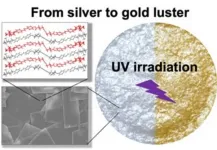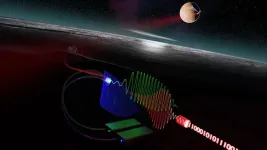Exploring the cost and feasibility of battery-electric ships
2024-10-30
(Press-News.org)
— By Jessica Scully
Retrofitting a portion of the US shipping fleet from internal combustion engines to battery-electric systems could significantly reduce greenhouse gas emissions and be largely cost effective by 2035, according to a new study from Berkeley Lab researchers recently published in Nature Energy.
Shipping represents 3% of total US greenhouse gas emissions from transportation, making it an important target for decarbonization. But electrifying ships is more challenging than electrifying cars from both a technical and a market perspective. A ship is a much bigger capital investment than a car and has a lifespan of several decades. While better battery technology in recent years has meant EVs with longer ranges, ships are vastly heavier than cars and can travel very long distances between ports. These heavy weights and long distances have led some to think that electrifying shipping isn’t feasible.
The researchers decided to test that assumption, said Won Young Park, the study’s lead and an energy policy researcher at Berkeley Lab.
“Our analysis includes the feasibility of electrification for 100% of all trips, while also exploring excluding a small percentage of very long single trips, which could be potentially addressed through optimized operations across multiple vessels,” he said. “Declining battery costs coupled with increasing battery energy densities, cleaner grids, optimized vessel operations, and valuing the battery’s second life create a unique electrification opportunity in domestic shipping.”
The researchers analyzed US-flagged ships less than 1,000 gross tonnage, which includes primarily passenger ships and three types of tugboats. They identified 6,323 such ships. Of those, 2,722 had enough data from the Automatic Identification System, an automatic tracking system for vessels, to understand the length and patterns of the trips they made.
Park and his colleagues found that excluding just 1% of the longest trips made electrifying the ships much more feasible, allowing for batteries two-thirds smaller than would be needed for the longest trips. For passenger ships, the size could be reduced by 85%, they found.
How much electrification reduces emissions depends on the carbon intensity of the electricity used for charging. These 6,323 ships contribute 9.5% of the total US domestic shipping emissions, according to the paper. The researchers looked at three scenarios for the carbon intensity of the electrical grid over time. Scenario one was the status quo, scenario two was 95% electricity decarbonization by 2050, and scenario three a more aggressive 95% decarbonization by 2035. Retrofitting these ships could reduce maritime CO2 equivalent emissions by 34-73% in 2035, with the highest reduction reached through the third scenario.
The researchers also looked at how electrifying shipping could be cost effective, meaning that retrofitting to battery electric costs the same or less as operating an equivalent internal combustion engine vessel. For internal combustion engine ships, total cost included fuel, operations and maintenance, and the social cost of CO2 equivalent emissions and air pollution. For the battery-powered ships, total cost included batteries, charging, operations and maintenance, cost for charging infrastructure, the social cost of CO2 equivalent emissions, and the battery’s second-life value at the end of first life. The researchers compared these costs under scenarios again including the percentage of total trips, carbon intensity of the electrical grid, and different cost scenarios for the battery system and charging costs.
In the 95% electricity decarbonization by 2035 scenario, electrifying up to 85% of these ships covering 99% of annual trips would be cost effective in 2035, they found.
The researchers also studied how much charging energy the ships would need for successful electrification. They found about half of the charging needs could be concentrated at 20 US ports.
"The electrification potential is concentrated at relatively few ports, including New York–New Jersey, New Orleans, and Houston,” said Hee Seung Moon, a Berkeley Lab postdoctoral researcher and first author of the paper. “This implies that focusing infrastructure investments on these ports will facilitate vessel electrification."
“Our analysis offers an essential first step in understanding battery-electric shipping options,” Park said. “It lays a foundation for future research and policy development to identify optimal locations for prioritizing battery electrification based on individual ship activity and local grid emissions.”
This research was supported by the Maritime Administration (MARAD) of the U.S. Department of Transportation.
###
Lawrence Berkeley National Laboratory (Berkeley Lab) is committed to delivering solutions for humankind through research in clean energy, a healthy planet, and discovery science. Founded in 1931 on the belief that the biggest problems are best addressed by teams, Berkeley Lab and its scientists have been recognized with 16 Nobel Prizes. Researchers from around the world rely on the Lab’s world-class scientific facilities for their own pioneering research. Berkeley Lab is a multiprogram national laboratory managed by the University of California for the U.S. Department of Energy’s Office of Science.
DOE’s Office of Science is the single largest supporter of basic research in the physical sciences in the United States, and is working to address some of the most pressing challenges of our time. For more information, please visit energy.gov/science.
END
ELSE PRESS RELEASES FROM THIS DATE:
2024-10-30
Australian researchers have developed a new method for spotting plastic rubbish on our beaches and successfully field tested it on a remote stretch of coastline.
The satellite imagery tool developed by RMIT University scientists picks up differences in how sand, water and plastics reflect light, allowing plastics to be spotted on shorelines from more than 600km above.
Satellite technology is already used to track the massive amounts of plastic floating around our oceans – from relatively small drifts containing thousands of plastic bottles, bags and fishing nets, up to gigantic ...
2024-10-30
Three teams led by Weill Cornell Medicine scientists have received awards from the Starr Cancer Consortium in its 17th and final annual grant competition. The grants will fund research on the deep mechanisms of common cancers and related treatment strategies.
The Starr Cancer Consortium, established in 2006 with generous support from The Starr Foundation, includes The Broad Institute of MIT and Harvard, Cold Spring Harbor Laboratory, Memorial Sloan Kettering Cancer Center, The Rockefeller University and Weill Cornell Medicine. The consortium’s goal has been to encourage highly collaborative and transformative research on cancer biology and novel treatment strategies. ...
2024-10-30
Homelessness among people over the age of 50 is on the rise, a phenomenon formal housing strategies often overlook -- but researchers from the University of Toronto and McGill hope to prevent this oversight in the future.
A new study published in The Gerontologist now provides a clear definition of late life homelessness informed by the lives and experiences of older adults. Drawing on interviews with older people who are unhoused and community workers in Montreal, Canada, the researchers aim to spark ...
2024-10-30
Background and objectives
Gelsemium elegans Benth (G. elegans) is a traditional medicinal plant; however, it is highly toxic, and toxicity varies significantly between species. The cause of this difference has not been clarified. Humantenirine is an important toxic alkaloid in G. elegans, and its metabolism has been poorly studied. This study aimed to compare the different metabolites formed by human liver microsomes, pig liver microsomes, and goat liver microsomes.
Methods
High-performance liquid chromatography/quadrupole time-of-flight mass spectrometry was used to study the metabolism of humantenirine in human liver microsomes, ...
2024-10-30
In fire-prone areas, water isn’t the only thing used to quell blazes. Wildland firefighters also apply chemical or synthetic suppressants. Researchers reporting in ACS’ Environmental Science & Technology Letters explored whether these suppressants could be a source of elevated metal levels sometimes found in waterways after wildfires are extinguished. Several products they investigated contained high levels of at least one metal, including chromium and cadmium, and could contribute to post-fire increases in the environment.
“Wildfires ...
2024-10-30
As a leader in academic health and biomedical research training, the Texas Tech University Health Sciences Center (TTUHSC) covers the West Texas region that comprises half of the state’s land mass and is home to 10% of its population. Research at TTUHSC drives innovation and discovery, changing the lives of those it serves and attracting talented faculty, staff and students.
During the latest reporting period (2020-2022), TTUHSC received an average of $12,539,679 annually in National Institutes ...
2024-10-30
Societies of the past and present have given high regard to precious metals like gold and silver. Both metals remind us of nobility and luxury. However, they are quite expensive, which restricts their applications. Therefore, materials with attractive but artificial gold- and silver-like metallic lusters are popular, finding use in jewelry, reflective materials, inks, and cosmetics.
Unfortunately, typical metallic luster materials cause environmental harm, rendering them unsustainable. Thus, scientists are actively searching for metal-free alternatives. In this direction, the research fraternity ...
2024-10-30
In space exploration, long-distance optical links can now be used to transmit images, films and data from space probes to Earth using light. But in order for the signals to reach all the way and not be disturbed along the way, hypersensitive receivers and noise-free amplifiers are required. Now, researchers at Chalmers University of Technology, in Sweden, have created a system that, with a silent amplifier and record-sensitive receiver, paves the way for faster and improved space communication.
Space communication systems are increasingly based on optical laser beams rather than radio waves, as the signal loss has been shown to be less when light is used ...
2024-10-30
Embargoed Until 10/30/24 at 7 am
PhD in Public Health candidate Elaine Russell and her mentor Kenneth Griffin, professor in the department of Global and Community Health, in George Mason University’s College of Public Health, worked with Tolulope Abidogun, also a PhD in Public Health student, and former Global and Community Health professor Lisa Lindley, now of Lehigh University, to analyze data from the American College Health Association National College Health Assessment (ACHA-NCHA III) in an effort to understand how university ...
2024-10-30
PHNOM PENH, Cambodia (October 30, 2024) – The first-ever camera trap study of the Central Cardamom Mountains Landscape has recorded 108 species, 23 of which are listed at risk (Vulnerable or above) on the IUCN Red List, underscoring the significance of the region as a global stronghold for biodiversity and rare and threatened species.
Editors please note: Use these links to access camera trap footage and the full report.
The report, released today by the Cambodian Ministry of Environment (MoE), the United States Agency ...
LAST 30 PRESS RELEASES:
[Press-News.org] Exploring the cost and feasibility of battery-electric ships





